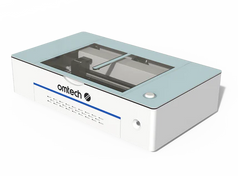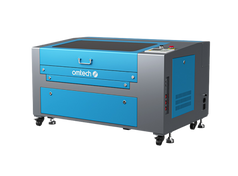Comprehensive Guide to Wood Laser Engraving Settings
Are you eager to unlock the full potential of your wood laser engraving endeavors? Look no further! This comprehensive guide delves deep into the realm of wood laser engraving settings, offering insights into laser power and speed optimization, along with tips for achieving impeccable engraving outcomes.
Wood laser engraving machine presents boundless creative possibilities, from personalized gifts to intricate designs on furniture and decor. However, to attain professional-grade results, it's imperative to grasp and fine-tune the laser engraving parameters and settings. Let's embark on this journey together and unveil the secrets to successful wood laser engraving!

Fine-Tuning Laser Engraving Parameters and Settings
Wood engraving involves adjusting laser power settings as part of the overall engraving parameters. Laser power determines the intensity of the laser beam used to engrave the wood surface.
When setting the laser power for wood engraving, factors such as wood type, thickness, and desired engraving depth must be considered. For softwoods, recommended power settings typically range from 30-50% of the laser's maximum power, translating to 15-25W for a 50W laser, paired with a speed of 300-400 mm/s. Conversely, harder woods like oak or maple may necessitate higher power settings, around 40-60% of the laser's maximum power, with speeds of 200-300 mm/s.
Finding the optimal laser power setting entails experimentation and testing on sample wood pieces. It's essential to start with lower power settings and gradually increase them until the desired engraving depth and quality are achieved. Additionally, factors like laser beam speed and wood grain density can influence the effectiveness of power settings, necessitating adjustments for consistent and precise engraving results across various wood types.
In essence, laser power settings are a critical component of wood engraving parameters. By meticulously adjusting power based on wood characteristics and engraving requirements, you can create exquisite wood engravings with accuracy and finesse.
Fine-Tuning Speed Settings for Wood Engraving
Optimizing speed settings is fundamental for wood engraving, significantly impacting engraving quality and efficiency. Speed settings determine how quickly the laser beam moves across the wood surface during engraving, influencing engraving depth, edge quality, and overall productivity.
When adjusting speed settings, considerations include wood type, density, and desired detail level. Softwoods may benefit from higher speeds to prevent burning, while harder woods may require slower speeds for adequate penetration and detail.
The intricacy of the design also influences speed settings. Intricate designs may require slower speeds for crisp lines and patterns. Starting with moderate speed settings and making adjustments based on outcomes is recommended.
Balancing speed and engraving quality is crucial. While faster speeds enhance productivity, they may compromise engraving quality, especially in detailed designs.
In summary, optimizing speed settings is vital for wood engraving success. By adjusting speeds based on wood type, design complexity, and desired quality, you can achieve efficient, high-quality engravings tailored to your specifications.
Selecting the Right Laser Focus for Wood Engraving
Choosing the appropriate laser focus is pivotal for wood engraving, directly impacting engraving quality and precision. Laser focus determines the size and intensity of the laser spot, affecting detail level, engraving depth, and overall clarity.
A smaller focus creates finer, more precise engravings, ideal for intricate designs and small text. Larger focuses result in broader, less detailed engravings, suitable for larger designs or rapid engraving.
Focus choice depends on wood thickness and type. Experimentation is key to finding the ideal focus for wood engraving, starting with a moderate focus size and adjusting as needed for desired detail and speed.
Balancing focus size, speed, and quality is essential for optimal wood engravings. By selecting the right focus based on design complexity and wood type, you can achieve high-quality engravings meeting your specific needs.
Tips for Successful Wood Laser Engraving

Utilizing Vector Lines
Vector lines are crucial for precise engraving, offering accuracy, clarity, and consistency. They are resolution-independent, scalable, and result in clean edges without blurring.
Enhancing Image Quality
Starting with high-resolution images or vector graphics, optimizing contrast and brightness, and selecting appropriate engraving modes improve image clarity and definition.
Managing Heat
Controlling laser power and speed, optimizing laser focus, implementing cooling mechanisms, and ensuring proper ventilation are essential for managing heat during engraving.
Safety Precautions and Maintenance
Proper Machine Handling
Ensuring operator safety and machine efficiency during wood engraving processes is vital when using laser engraving machines. Proper training is key to equip operators with the necessary skills for safe machine operation. Following manufacturer guidelines, including correct installation, alignment, and regular maintenance, is crucial to prevent potential safety risks.
During operation, operators must wear appropriate personal protective equipment (PPE) like laser-rated safety goggles and gloves to shield against laser beams and hot materials. Care should be taken when loading and unloading materials to avoid accidental contact with moving parts or the laser beam.
In case of emergencies, operators should be familiar with shutdown procedures to power off the machine safely. Clear communication channels and emergency contact details should be easily accessible for quick response and assistance.
By emphasizing proper handling and adherence to safety measures, operators can establish a secure working environment conducive to successful wood engraving projects. Encouraging a culture of safety awareness promotes proactive risk mitigation and helps prevent workplace accidents.
Regular Maintenance
Regular maintenance of laser engraving machines is crucial for operator safety during wood engraving processes. Following a maintenance schedule helps identify and address potential hazards and malfunctions promptly, reducing the risk of accidents and injuries.
Routine maintenance tasks involve cleaning the machine, inspecting components for wear and damage, and lubricating moving parts as needed. Keeping the machine clean and well-maintained helps minimize debris buildup and mechanical failures that could compromise safety.
Regular calibration and alignment checks are also essential to ensure the accuracy and precision of the laser beam. Misaligned or improperly calibrated lasers can pose safety risks by producing unpredictable engraving results or emitting beams outside the intended path.
By conducting regular maintenance procedures, operators can uphold optimal machine performance and reduce the likelihood of malfunctions during wood engraving operations. Prioritizing regular maintenance as part of a comprehensive safety program creates a secure working environment and enhances the longevity of the equipment.
OMTech MF2028-80: Elevate Your Woodworking Projects
The OMTech MF2028-80 is a powerful CO2 laser cutting and engraving machine designed to enhance woodworking projects. With features like an 80W CO2 laser, versatile work area, advanced control system, precision components, safety features, and compatibility with LightBurn software, this machine offers unparalleled precision and efficiency for cutting and engraving tasks.
Key Features:
-
Powerful Laser: Cuts wood up to 10 mm thick with 80W CO2 power, suitable for hardwoods like oak and maple, as well as softer woods like pine and cedar.
-
Versatile Work Area: Allows for large-scale projects with a four-way pass-through feature and a 20” x 28” workspace, accommodating various wood materials.
-
Advanced Control: Easy control with the RYXON Digital Controller for precise settings and compatibility with RDWorks v8.
-
Precision and Durability: Ensures accurate cuts and engravings with a linear rail guiding system and X and Y stepper motors.
-
Safety Features: Includes flame-retardant materials, widened viewing window, air assist, built-in ventilation, water flow sensor, and automatic shutdown for safety compliance.
-
Software Compatibility: Works seamlessly with LightBurn Software for creative customization, suitable for hobbyists and professionals.

Conclusion
By mastering wood laser engraving parameters, experimenting with settings, prioritizing safety, and utilizing advanced machines like the OMTech MF2028-80, you can unlock your creativity and achieve stunning results in your wood engraving projects!
FAQs about Wood Laser Engraving Settings
1. What is the best setting for laser-cutting wood?
The best setting for laser cutting wood involves moderate power and speed settings to achieve clean cuts without charring, with adjustments based on wood type, thickness, and cutting depth.
2. What frequency should the laser be for cutting wood?
Laser cutting wood typically requires a frequency between 10,000 and 50,000 Hz, varying based on wood type, thickness, and machine capabilities.
3. What wattage laser is ideal for engraving wood?
The ideal laser wattage for engraving wood varies depending on wood type and desired depth. Softer woods like pine typically suit 40-60 watts, while harder woods like oak may require 80-120 watts, considering project requirements when selecting wattage.























